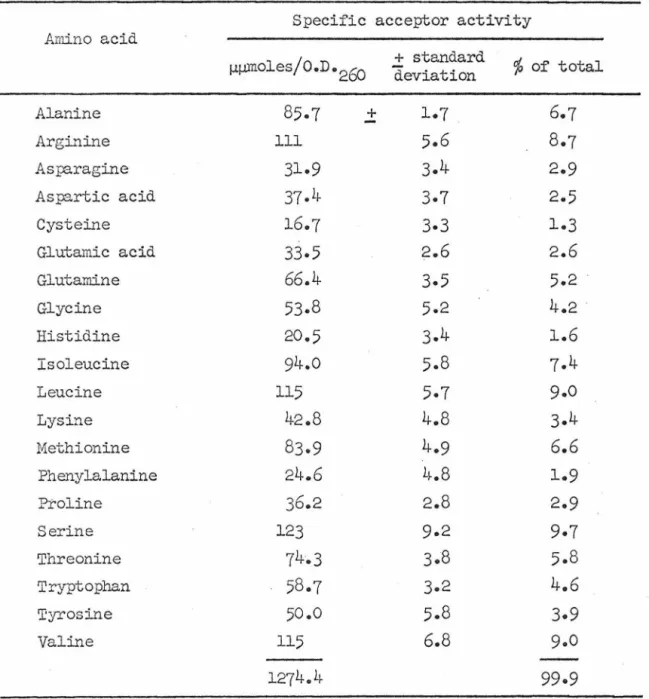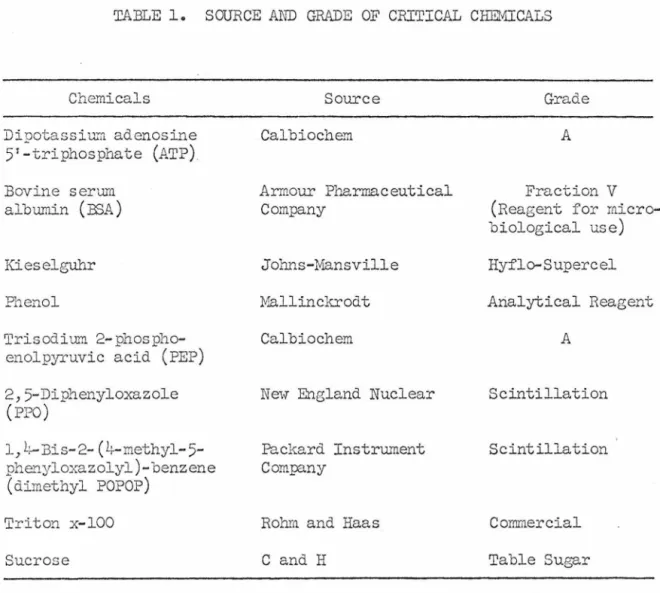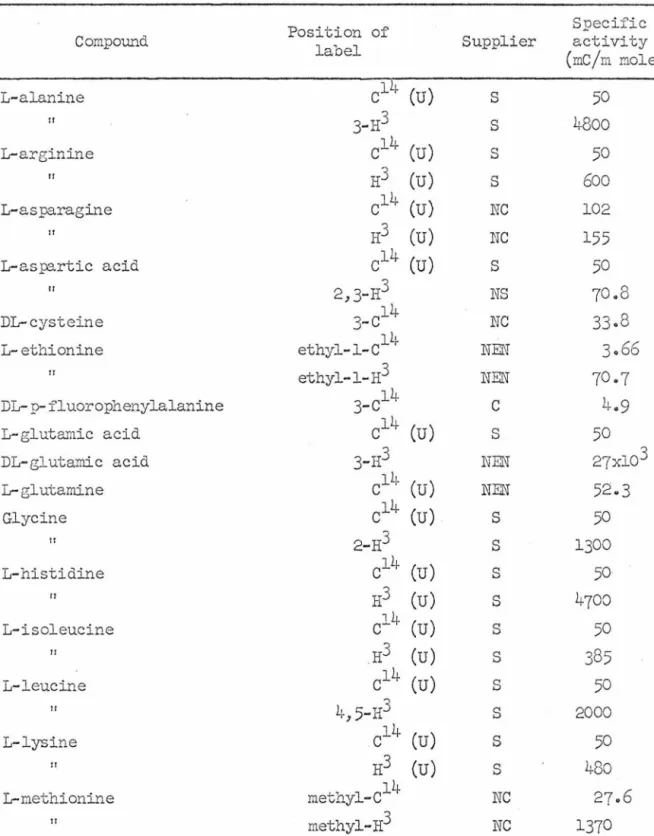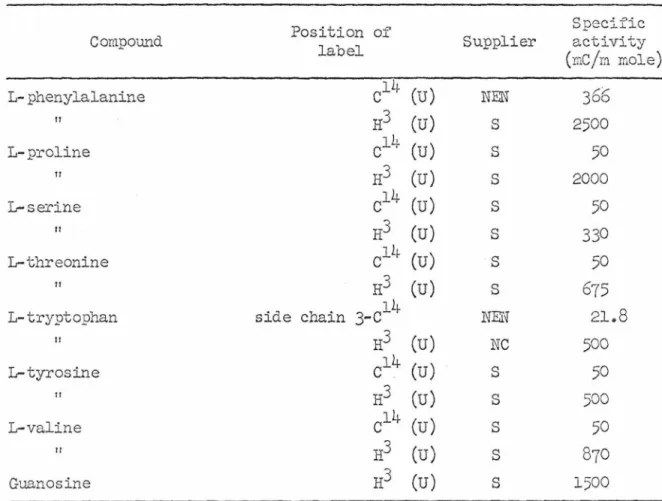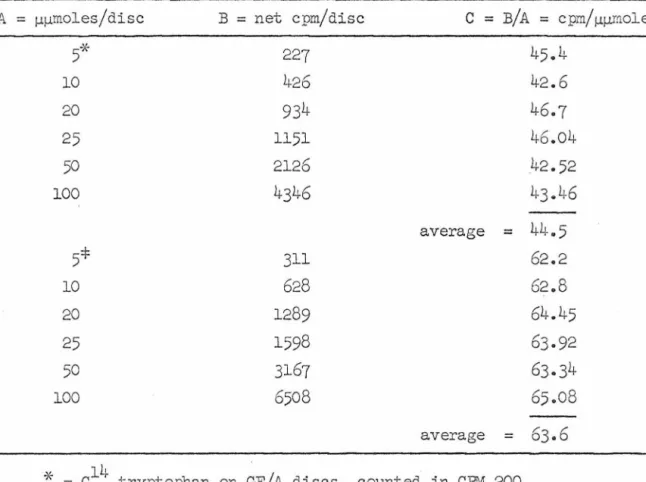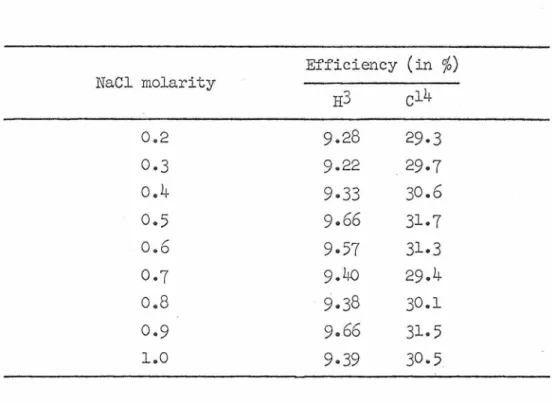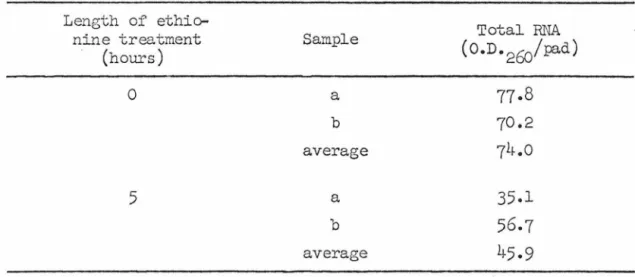The coding behavior of each of the leucil-tRJ.IJA components before and after -Y/3.S infection. Strain 74A was grown exponentially according to a modification of the methods of Luck (35) and Davis and Harold (36). Since PCA does not absorb in the 260 mµ region, the amount of nucleic acid can be measured directly from the absorbance at 260 mµ of the hot acid fraction.
The actual mixture proportions were dictated by the large sample size and high ionic strength. This allows semi-quantitative comparisons to be made by simply inspecting the chromatographic profile. An important point is that addition of an amino acid analog stimulates rapid net synthesis of tyrosinase.
Under the conditions used, the addition of ethionine leads to a slight decrease in the dry mass of the mycelium. The time scale of the ordinate is relative to the time of ethionine addition (arrow).

TREATE D
During the period of maximum rate of tyrosinase synthesis, the rate of general protein synthesis, as measured by the incorporation of tritiated phenylalanine into TCA-insoluble material, decreases slightly. This rate calculation depends on the hypothesis that the mole fraction of phe in protein remains constant after ethionine treatment (50). After the addition of ethionine, the total accumulation of mycelial soluble protein drops sharply and then levels off after 10 h (Figure 4).
The decrease in the rate of protein synthesis is not nearly large enough to explain this change in protein content. I measured the sRNA content of mycelium several times, both before and after the addition of ethionine and the resulting stimulation of tyrosinase synthesis (Figure 5). Pads spread between sheets of paper towels were used for wet weight determination (circles) and then tested for tyrosinase (Figure 2).
ETHIONI NE
The other two cultures were first treated with ethionine for five hours and then pulsed and fractionated. For the conversion of amino acid incorporation from µmol to mg, H, I calculated the number average molecular weight of amino acid residues in Neurospora protein (108.72) based on the published composition (49).
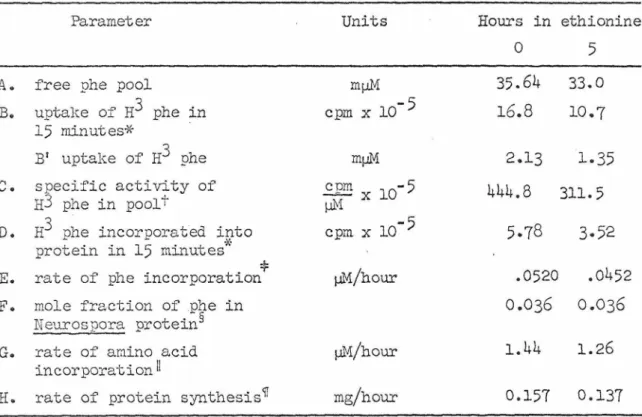
ETH! ONI NE T REATED
The response of the mycelium to the addition of ethionine includes a rapid loss of sRL\JA. The rate of synthesis of sRNA measured by incorporation of tritiated guanosine is reduced after addition of ethionine to approx. 30% of the pretreatment rate (Table 7). The chromatographic profile of the newly synthesized material at the two time points is qualitatively quite similar (Figure 6).
I have investigated the rate of methylation of sRNA in vivo in zero-hour control and 5-hour ethionine-treated culture by measuring the incorporation of pH 8.8 stable methyl groups into sRNA during a 15 minute pulse of methionine isotopically labeled in the methyl group, and have compared the specificity of methylation by MAK chromatography of the pulse-labeled material (Figure 7). There is no striking qualitative difference in the material extracted from the two cultures, although the extent of methylation is reduced in the ethionine-treated cultures by 20-25%·. Incubation of the RNA preparations at 37°C, pH 8.8 eliminated the possibility that any of the counts were in the form of methionyl-tRNA.
Such preparations showed enzymatic activity when measured by the conversion of the radioactive amino acid (methionine or leucine) to a form insoluble in ethanol or cold acid, in the presence of sRNA. To circumvent problems caused by contamination of the aminoacyl-tRNA synthetase preparation with ribonuclease, I attempted several times to load tR.'rifA in vivo. TARN extracted from cultures pulsed with radioactive leucine, phenylalanine, or methionine contained no detectable labeled aminoacyl-tRNA.
Generally, a sulfhydryl reducing agent is also added because many of the synthetase enzymes contain sulfhydryl groups. There are two criteria used to determine the saturation or maximum acceptor activity of tRJ.lffi for a particular amino acid. The interpretation of such evidence is that every tRNA molecule capable of accepting the amino acid has by then reacted with it.
Four observed patterns of the amount of aminoacyl-tfu'IIA (in arbitrary units) recovered from the reaction mixture as a function of time.
The amount of aminoacyl-tRNA formed reaches a peak within 5-10 minutes and then decreases (curve IV, Figure 8). The eluted fractions were pooled into 4 groups (A, B, C, D) based on the expected mobility of the 4 serine-tRiiffi components. The instability of the aminoacyl-tRNA was confirmed for alanine and methionine by extracting the peak material and reincubating it in buffer (Figure 10).
However, the instability of the aminoacyl-tRNA is not sufficient to explain the observed type IV kinetics. Since as long as all the components are necessary for the formation of the product. The addition of ATP during the course of the reaction results in a burst of charging.
These results indicate that in the initial phase of the incubation, in addition to the amino acid being attached to tRNA at the expense of an equivalent amount of ATP, most of the excess ATP present (> 1000-fold) is hydrolyzed. Unlike the aminoacyl-tRNA formed with the 4 other amino acids that exhibits type IV kinetics in the loading reaction, glycyl-tRNA. If transfer RNA modifications were involved in the regulation of the ethionine-mediated metabolic shift described above, then changes in the chromatographic profile of the tRNA specific for at least one amino acid should be observed.
The rest of the data extracted from the chromatographic profiles are summarized in Table 13. The amount of tRNA for each of the 5 amino acids with an aminoacyl-tRJ.lfA component showed a difference. The relative proportion of components for 14 of the 15 amino acids with multiple aminoacyl-tRNA components remains the same.
For 18 of the 20 amino acids, tRNA extracted from one culture was loaded with c14 amino acid and co-chromatographed with tRNA extracted from the other type of culture, loaded with the same amino acid labeled with tritium.
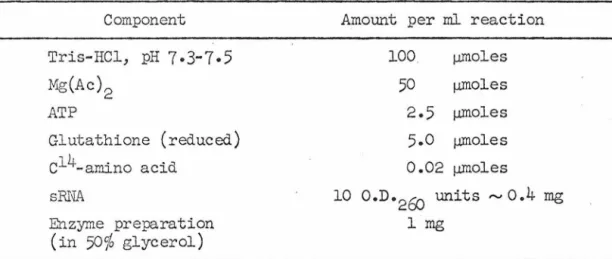
ISER ~
GLY ~ PRO
ASP ASN
I LYS
FRA CT ION NU MBE R
Relative acceptor activity is the amount of aminoacyl-tRllJA from ethionine-treated cultures (E) relative to vegetative controls (c). Relative proportion is determined by the number of counts below each peak or shoulder and expressed as a percentage of the total. Each of 7 different chromatographic profiles of serial tRNA shows unique proportions of the 4 components.
This result can be explained by either postulating that the tRNA that was chromatographed was not completely charged in each case or that interconversion of the 4 components takes place. In order to further explore the quantitative differences indicated by the chromatographic data, tRNA was extracted from 5 cultures grOim for different lengths of time without ethionine and from 7 cultures after different lengths of ethionine treatment; the tRNA is tested by the filter paper disk method for specific acceptor activity (total .. µµ.~oles of amino acid attached per o.n.260 unit of unfractionated tRNA). The specific acceptor activity of tRNA from control cultures for glutamine, determined by direct assay, is divided between the two components according to chromatographic evidence.
The ethionine-treated culture yielded tRNA with 66.1% as much activity for glutarylin and this is also tabulated by. The total acceptor activity is the sum of 20 separate acceptor activities determined individually for each sample. The loss occurs mainly from a reduction in the specific acceptor activity for asparagine, glutamine and cysteine.
For 4 of the amino acids (valine, tryptophan, aspartic acid, and phenylalanine), there is no pattern of significant change in specific acceptor activity whether or not ethionine is added. The additional three mentioned earlier (cysteine, asparagine, glutarnine) lose their acceptor activity regardless of whether it is ethionine or not. Alanine (triangles) represents the 13 amino acids for which it is characteristic. acceptor activity declines in response to ethionine. represents 4 amino acids in which the specific acceptor activity remains unchanged.
The specific acceptor activity of aspa.ragine. circles) and 2 other amino acids decrease whether or not ethionine is added.
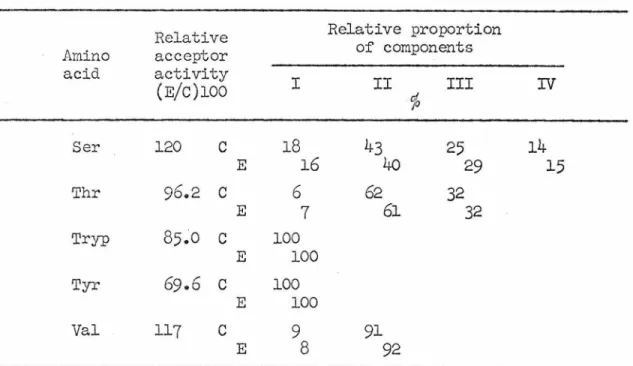
ALANINE
Each value is expressed as the percentage it is of the radioactivity attached in the absence of competing unlabeled material. The total acceptor activity provides an estimate of the extent of transfer RNA in the preparation that is operationally totally soluble. The distribution of acceptor activity (expressed in %) shows no striking relationship with the amino acid composition of total soluble protein, nor with the composition of the free amino acid pools.
The amino acid composition of the whole mycelium is equal to the protein composition, because the pool contains only 16% of the total amino acids. Since the distribution of tfu'IA is not indicative of the average amino acid composition of protein, these parameters can be related to. The degeneracy of tRl~A is commonly reflected by chromatographic heterogeneity of aminoacyl-tRl~A (67, 68) or by separation of acceptor activities for a given amino acid using countercurrent distribution (69, 70).
In 1966, Crick proposed the oscillation hypothesis to systematically explain the nature of code degeneration (72). In each of these organisms, there is a strong tendency to accumulate the minimum number of components necessary to decode all the codons for each amino acid. As mycelial mass only slightly decreases during this same period, it is assumed that the accumulation of insoluble proteins is increased.
With a single exception, if these quantitative changes do not affect multicomponent amino acyl-tRNAs, e.g. valyl-tRll!A (Figure 12), each component changes proportionally, ie. the relative proportion of the several components remains constant. Some of the variability arises from variability in the loading efficiency of tRNA mixtures prepared by the same procedure on different days. For the remaining 13 amino acids, treatment with ethionine after 10 hours results in a significant decrease in specific acceptor activity (25-50%).
The nature of the changes reported here differs from all published cases of tRNA changes accompanying differentiation. This may simply be a consequence of the proximity of the molecule's nuclease-sensitive sequences to the region important in determining amino acid acceptance. If a regulatory function were involved in these types of changes, you would expect the average amino acid composition of the mycelial proteins to change.
